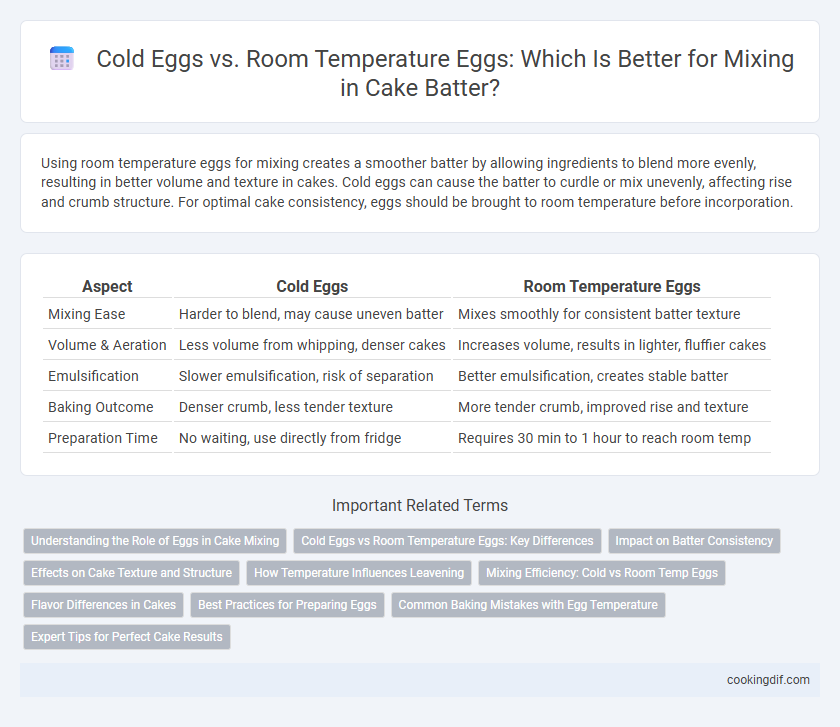Using room temperature eggs for mixing creates a smoother batter by allowing ingredients to blend more evenly, resulting in better volume and texture in cakes. Cold eggs can cause the batter to curdle or mix unevenly, affecting rise and crumb structure. For optimal cake consistency, eggs should be brought to room temperature before incorporation.
Table of Comparison
| Aspect | Cold Eggs | Room Temperature Eggs |
|---|---|---|
| Mixing Ease | Harder to blend, may cause uneven batter | Mixes smoothly for consistent batter texture |
| Volume & Aeration | Less volume from whipping, denser cakes | Increases volume, results in lighter, fluffier cakes |
| Emulsification | Slower emulsification, risk of separation | Better emulsification, creates stable batter |
| Baking Outcome | Denser crumb, less tender texture | More tender crumb, improved rise and texture |
| Preparation Time | No waiting, use directly from fridge | Requires 30 min to 1 hour to reach room temp |
Understanding the Role of Eggs in Cake Mixing
Eggs play a vital role in cake mixing by providing structure, moisture, and leavening through the incorporation of air. Room temperature eggs blend more easily with other ingredients, promoting better emulsification and a smoother batter, which leads to a lighter, fluffier cake texture. Cold eggs, on the other hand, can cause uneven mixing and reduce the ability to trap air, resulting in denser cakes and less consistent crumb.
Cold Eggs vs Room Temperature Eggs: Key Differences
Cold eggs have a thicker consistency, resulting in less volume when whipped, while room temperature eggs whip up more easily and trap more air for a lighter cake texture. Using room temperature eggs improves emulsification, leading to better batter blending and a more uniform crumb structure. Cold eggs can slow down the mixing process and cause uneven ingredient incorporation, impacting the final cake rise and moisture distribution.
Impact on Batter Consistency
Using room temperature eggs in cake batter results in a smoother, more consistent mixture, as they blend easily with other ingredients, ensuring even moisture distribution. Cold eggs can cause the fat in butter or shortening to harden, leading to a lumpy batter that is difficult to emulsify properly. This difference directly impacts the cake's texture, with room temperature eggs promoting better volume and lighter crumb.
Effects on Cake Texture and Structure
Using cold eggs in cake batter can result in a denser texture because they slow down the emulsification process, leading to less uniform mixing of fats and liquids. Room temperature eggs blend more easily with other ingredients, promoting better aeration and a lighter, fluffier cake structure. This improved emulsification enhances the cake's volume and tenderness by allowing stable incorporation of air bubbles during mixing.
How Temperature Influences Leavening
Room temperature eggs incorporate more air when beaten, enhancing leavening and resulting in a lighter, fluffier cake texture. Cold eggs tend to resist aeration, leading to denser batter and less volume in the final product. Optimal leavening depends on the egg's temperature, influencing gas retention and batter rise during baking.
Mixing Efficiency: Cold vs Room Temp Eggs
Room temperature eggs blend more efficiently into cake batter, creating a smoother, more uniform mixture that traps air for better rise and texture. Cold eggs can cause fats and other ingredients to seize, resulting in uneven mixing and denser cake crumb. Professional bakers recommend using eggs at around 70degF (21degC) to optimize emulsification and batter consistency.
Flavor Differences in Cakes
Using room temperature eggs in cake mixing enhances flavor extraction and emulsification, resulting in a richer, more pronounced taste profile. Cold eggs can cause batter to seize and may inhibit proper mixing, leading to denser cakes with muted flavor notes. Scientific studies show that room temperature eggs blend more evenly with fats and sugars, optimizing flavor development during baking.
Best Practices for Preparing Eggs
Using room temperature eggs in cake batter improves emulsification and creates a smoother, more uniform mixture, enhancing the cake's texture and rise. Cold eggs can cause the batter to seize or clump, leading to uneven baking and denser cakes. For best results, let eggs sit at room temperature for 30 minutes before mixing to optimize incorporation and consistency.
Common Baking Mistakes with Egg Temperature
Using cold eggs directly from the refrigerator can cause improper emulsification in cake batter, leading to uneven texture and reduced volume. Room temperature eggs blend more seamlessly with other ingredients, promoting better aeration and smoother consistency in the final cake. A common baking mistake is neglecting to warm eggs before mixing, which compromises the cake's rise and overall crumb structure.
Expert Tips for Perfect Cake Results
Using room temperature eggs for cake mixing ensures better incorporation with butter and sugar, leading to a smoother and more stable batter. Experts recommend letting eggs sit out for about 30 minutes before baking to achieve optimal emulsification, which helps produce a light and tender crumb. Cold eggs can cause the batter to curdle and reduce volume, negatively impacting the cake's texture and rise.
Cold Eggs vs Room Temperature Eggs for mixing Infographic

 cookingdif.com
cookingdif.com